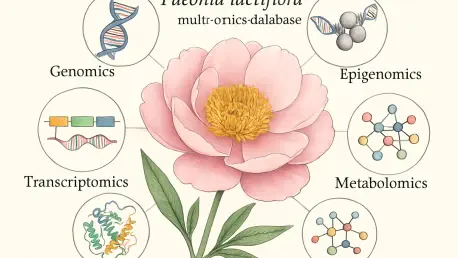In the realm of plant science and traditional medicine, few species hold as much cultural, ornamental, and therapeutic value as Paeonia lactiflora, commonly known as the Chinese peony. This perennial herbaceous plant, native to East Asia, has been revered for centuries not only for its stunning blooms but also for its roots, which are processed into potent herbal remedies used in traditional Chinese medicine (TCM). With the rapid advancements in omics technologies—spanning genomics, transcriptomics, proteomics, and metabolomics—a vast amount of data has been generated about this remarkable plant. However, the challenge lies in organizing and accessing this wealth of information for practical research and application. Enter a groundbreaking resource designed to tackle this issue: a comprehensive multi-omics database tailored specifically for P. lactiflora. This platform integrates diverse datasets, offering researchers a centralized hub to explore the plant’s genetic makeup, bioactive compounds, and biosynthetic pathways. By bridging the gap between raw data and actionable insights, this database promises to revolutionize studies in cultivation, breeding, and medicinal development, paving the way for innovations in both plant science and modern pharmacology.
1. Exploring the Historical and Medicinal Roots of a Cherished Plant
Paeonia lactiflora, often dubbed the “Prime Minister of Flowers,” carries profound cultural significance in East Asian traditions, with references dating back to ancient texts from the 6th century BCE. Its striking flowers symbolize beauty and love, appearing as a recurring motif in poetry and art across centuries. Beyond aesthetics, the plant’s roots hold a pivotal role in Traditional Chinese Medicine (TCM), documented in early pharmacological works as a key ingredient in numerous remedies. Processed into forms known as Bai Shao and Chi Shao, these roots are integral to formulas that address a range of ailments, highlighting their enduring therapeutic relevance. Modern studies have validated these historical uses by identifying active compounds like paeoniflorin, which exhibits analgesic, anti-inflammatory, and immunomodulatory effects. Such findings underscore the plant’s potential as a foundation for contemporary drug development, blending ancient wisdom with cutting-edge science.
The Paeoniaceae family, to which P. lactiflora belongs, is unique with only one genus comprising around 30 species, many of which are cultivated for their ornamental appeal. Over 8,000 cultivars have been developed through hybridization, catering to horticultural markets while serving as vital resources for genetic research. Yet, challenges persist in fully utilizing these genetic assets due to gaps in understanding key biosynthetic pathways, such as that of paeoniflorin. Recent genomic advancements, including the sequencing of an 11.4 Gb genome for P. lactiflora anchored to five chromosomes, provide a critical foundation to address these gaps, enabling deeper exploration into functional genes and cultivar improvement.
2. Unveiling a Comprehensive Digital Repository for Plant Research
At the heart of modern research on P. lactiflora lies a newly developed multi-omics database, a digital platform that consolidates an extensive array of molecular and chemical data, making it an invaluable tool for scientists. This resource encompasses genomic sequences, transcriptomic profiles, proteomic datasets, and metabolomic information gathered from various tissues and growth stages of the plant. Additionally, it catalogs chemical compound profiles, details on biosynthetic pathways—particularly those linked to monoterpenoid glycosides like paeoniflorin—and documented pharmacological effects. Organized into distinct functional modules such as Home, Genome, Transcriptome, Proteome, Tools, Biosynthetic Pathways, Chemical Compounds, and Publications, the database offers a structured approach to data access. It is publicly accessible online, ensuring that researchers worldwide can tap into this treasure trove of information with ease.
Beyond mere data storage, this platform is designed to be user-friendly and interactive, catering to the needs of scientists focused on plant breeding, molecular pharmacognosy, and medicinal applications. The inclusion of analytical tools within the “Tools” module, such as sequence alignment, pathway enrichment analysis using the Kyoto Encyclopedia of Genes and Genomes (KEGG), protein structure prediction, and primer design, enhances its utility. By providing a centralized hub for over 55,000 protein-coding genes, thousands of metabolite entries, and numerous datasets, this database stands as a cornerstone for advancing systematic studies on P. lactiflora’s genetic and biochemical intricacies.
3. Navigating the Core Functional Modules of the Platform
The database is structured into several key modules, each tailored to specific aspects of P. lactiflora research, ensuring a comprehensive resource for scientific exploration. The Home module serves as the central hub, offering a navigation bar and an overview of the platform’s scope for easy access to other sections. The Genome module is particularly noteworthy, featuring a high-quality chromosome-level assembly of 11.4 Gb for P. lactiflora, alongside comparative data for related species like P. ludlowii. Submodules such as JBrowse facilitate detailed genome visualization, while evolutionary analysis and collinearity tools help uncover gene arrangements and conserved relationships. This wealth of genomic data, including annotations from databases like Gene Ontology (GO) and Swiss-Prot, supports in-depth genetic studies.
Other critical modules include Transcriptome, Proteome, and Metabolome, each providing specialized datasets to enhance research capabilities. The Transcriptome module offers RNA-Seq data across different tissues, with tools for differential expression analysis and KEGG pathway enrichment. The Proteome module details protein information, quantitative data, and visualizations like heatmaps for GO enrichment, while the Metabolome module catalogs metabolites with differential analysis across root, stem, and leaf tissues. Additionally, the Survey module presents genome survey results, including size and heterozygosity data, and the Literature module hosts over 100 publications for reference. Together, these components create a robust framework for exploring the plant’s molecular landscape.
4. Step-by-Step Guide to Using the Search Module for Gene Retrieval
For researchers seeking specific genetic information, the Search module offers a powerful toolset for data retrieval. To begin, navigate to the “Search” tab from the database homepage to access the Gene Search page. Enter a specific gene ID or a range of IDs into the search field to initiate the query process. The results will display comprehensive details, such as the chromosome location, start and end positions, and protein annotations linked to external databases like InterPro and TrEMBL. This structured output ensures that users can quickly grasp the genetic context of their target genes without navigating multiple sources.
To further enhance functionality, the Search module includes a “Sequence Fetch” feature for downloading nucleotide sequences, allowing users to specify start and end positions in the search box and click “Download” to retrieve sequences within the desired range. For those needing multiple sequences, the “Multiple Sequence Fetch” option enables inputting various regions into the “Region” search box for simultaneous downloads. This feature supports data retrieval for both P. lactiflora and related species like P. ludlowii, making it a versatile tool for comparative genomic studies and ensuring accessibility for diverse research needs.
5. Mastering Sequence Alignment with the BLAST Tool
The Tools module provides an array of analytical capabilities, with the BLAST (Basic Local Alignment Search Tool) feature standing out for sequence alignment. To utilize this, click on “Tools” in the navigation bar and select “BLAST.” Choose from alignment options such as “Blastn Gene,” “Blastn Genome,” or “Blastp” based on the specific requirements of the study. Input nucleotide or protein sequences in FASTA format into the search box, adjusting the query type if necessary to align with the intended analysis. This flexibility ensures compatibility with a wide range of sequence data.
Once the sequence is entered, click “Search” to obtain alignment results, which can be downloaded for further examination. This functionality is crucial for identifying similarities between sequences, aiding in gene function prediction and evolutionary studies. The BLAST tool’s ability to handle both nucleotide and protein data makes it indispensable for researchers exploring genetic relationships within P. lactiflora or comparing it with other species. Such precise alignment results contribute significantly to hypothesis testing and data validation in molecular biology projects focused on this plant.
6. Constructing Phylogenetic Trees for Evolutionary Insights
Another valuable feature within the Tools module is the ability to build phylogenetic trees, offering insights into evolutionary relationships. You can access this by selecting “Phylogenetic Tree” under “Tools.” Input nucleotide or protein sequences into the search box, noting that this tool is not restricted to database sequences—external sequences from other species can also be used. This broad compatibility allows for comprehensive comparative analyses across diverse plant taxa, enhancing the scope of evolutionary research.
After entering the sequences, run the tool to generate a phylogenetic tree using the maximum likelihood method, directly derived from alignment results. The resulting tree and associated data can be downloaded for further analysis or publication purposes. This functionality is particularly useful for understanding the genetic divergence and relationships within the Paeoniaceae family, providing a visual representation of how P. lactiflora relates to its kin. Such tools empower researchers to map out evolutionary histories with precision, contributing to broader studies in plant systematics.
7. Predicting Homologous Proteins for Functional Studies
The Tools module also facilitates homologous protein prediction, a critical step in understanding gene functions. Select the “Gene Prediction” option under “Tools” to start the process. Input nucleotide or protein sequences into the designated search boxes, ensuring that the data aligns with the intended analysis. Users can customize settings such as model and algorithm preferences to tailor the prediction process to specific research goals, enhancing the accuracy of the outcomes.
Once the parameters are set, click “Run” to obtain prediction results, which can include sequences from beyond the database’s current holdings. This feature supports a wide range of studies, from identifying potential functional analogs in P. lactiflora to exploring conserved proteins across species. The ability to predict homologous proteins aids in uncovering the roles of uncharacterized genes, particularly those potentially involved in bioactive compound synthesis like paeoniflorin. Such predictions are vital for advancing molecular biology and pharmacognosy research related to this plant.
8. Designing Primers for Targeted Genetic Amplification
For experimental applications, the database offers a “Primer Designer” tool within the Tools module, which is essential for genetic amplification studies. Access this by selecting “Primer Designer” under “Tools.” Manually input a sequence or specify a range for primer design within the provided interface. Adjust relevant parameters based on experimental needs, such as melting temperature or specificity requirements, to ensure the primers meet the desired criteria for successful amplification.
After setting the parameters, click “Search” to initiate the primer design process. The tool generates primer sequences optimized for the specified conditions, which can be used in polymerase chain reaction (PCR) experiments targeting specific regions of P. lactiflora’s genome. This functionality is crucial for studies aiming to validate gene functions or explore expression patterns in different tissues. By simplifying the primer design process, the database supports efficient experimental workflows, enabling researchers to focus on data interpretation rather than preparatory challenges.
9. Conducting Genome Alignment for Comparative Analysis
The Tools module extends its utility with a “Genome Alignment” feature, ideal for comparative genomic studies. Navigate to “Genome Alignment” in the navigation bar under “Tools.” Input gene sequences or FASTA format files into the two provided search boxes to set up the comparison. This feature supports the alignment of target sequences from other species, offering flexibility for cross-species analyses beyond P. lactiflora and its close relatives.
Click “Run” to execute the collinearity analysis and review the alignment output, which provides insights into conserved gene arrangements and structural variations. This tool is invaluable for understanding genomic similarities and differences, aiding in the identification of syntenic regions that may influence traits like medicinal compound production. By facilitating such detailed comparisons, the database enhances research into evolutionary biology and genetic engineering, providing a clearer picture of how genomic architecture shapes functional outcomes in P. lactiflora.
10. Performing GO/KEGG Enrichment Analysis for Pathway Insights
To delve into biosynthetic pathways and functional annotations, the database offers GO/KEGG enrichment analysis within the Tools module. Access this feature by selecting the enrichment analysis option under “Tools.” Enter gene IDs into the data box, which can include IDs obtained from other modules within the platform. This integration allows for seamless analysis of genes identified through transcriptomic or proteomic studies, ensuring a cohesive research experience.
Click “Run” to process the data and view results presented in both tabular and graphical formats for clear interpretation. These outputs highlight enriched pathways and functional categories, shedding light on the biological processes and metabolic routes active in P. lactiflora. Such analyses are particularly relevant for uncovering the mechanisms behind secondary metabolite production, like paeoniflorin synthesis. By providing accessible and detailed enrichment data, the database supports researchers in linking genetic information to practical applications in drug development and plant breeding.
11. Assessing the Platform’s Utility and Addressing Challenges
The multi-omics database for P. lactiflora serves as a transformative resource, facilitating in-depth studies of genetic characteristics, gene expression profiles, and functional proteins. It accelerates efforts in breeding new cultivars and applying functional genes for medicinal purposes, offering a systematic approach to understanding the plant’s molecular underpinnings. Key enzymes and genes related to paeoniflorin biosynthesis, such as farnesyl pyrophosphate synthase (FPS) and the BAHD-family O-benzoyltransferase PoDPBT, are accessible through the platform, providing a starting point for pathway elucidation despite remaining gaps in complete understanding.
However, certain limitations must be acknowledged. Data coverage remains incomplete, with some entries lacking comprehensive functional annotations or contextual metadata, potentially hindering interpretability. Update frequency is another concern, as the platform may not always reflect the latest discoveries in real time. Additionally, scalability challenges arise with the growing volume and complexity of biological data, necessitating ongoing infrastructure optimization. Future development plans include expanding data coverage, enhancing annotation depth, increasing update frequency, and incorporating user feedback to ensure the platform evolves with the research community’s needs.
12. Reflecting on a Milestone in Plant Science Research
Looking back, the establishment of this multi-omics database marked a significant achievement in the study of P. lactiflora, providing an interactive and comprehensive platform for integrating diverse datasets. Its tools and modules supported researchers in navigating the complexities of genomic, transcriptomic, proteomic, and metabolomic data with unprecedented ease. The commitment to long-term maintenance by the development team ensured that the resource remained a reliable cornerstone for scientific inquiry, addressing the evolving demands of plant science and the modernization of traditional medicine.
The impact of this database was profound, as it enhanced the understanding of bioactive compound biosynthesis, particularly for compounds like paeoniflorin with significant therapeutic potential. Moving forward, the focus should shift to leveraging this platform for collaborative research initiatives, encouraging global partnerships to fill remaining knowledge gaps. Exploring integration with other plant databases could further amplify its reach, while continuous updates with emerging omics data will sustain its relevance. This resource has laid a strong foundation for future breakthroughs, urging the scientific community to harness its capabilities for innovative solutions in cultivation, breeding, and pharmacological advancements.









